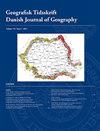Territorial competitiveness, cohesion and sustainability in Romania’s urban border areas
IF 1.1
4区 社会学
Q4 ENVIRONMENTAL STUDIES
Geografisk Tidsskrift-Danish Journal of Geography
Pub Date : 2021-01-02
DOI:10.1080/00167223.2021.1910055
引用次数: 1
Abstract
ABSTRACT Following the expansion of NATO in 2004 and the EU in 2007, Romania has become the Eastern frontier of these structures, which lends Romanian borders a strategic role. The territorial development of a border area is influenced by the political, economic, socio-cultural, demographic characteristics of the neighbouring countries sharing the same border. The border areas of Romania include 898 Local Administrative Units (LAU), of which 88 are urban. Romania has a border line (2956.4 km, of which 63.5% is non-European Union border) with the following countries: Bulgaria, the Republic of Moldova, Serbia, Ukraine, Hungary. The current paper seeks to identify the territorial disparities in the urban development of the Romanian border areas by 3 secondary indexes in order to reflect the main territorial development aspects: competitiveness (TComp), cohesion (TCoh), and sustainability (TSust). Lastly, the authors were able to establish the Index of Territorial Development (ITD) revealing the levels of territorial development. Assessing the competitiveness, cohesion and sustainability levels of urban centres is a useful and necessary stage, done through this study, for establishing those socio-economic fields, those towns and border sectors which are less developed, requiring attention from the regional, national and local administrations, reflected in investments.罗马尼亚城市边境地区的领土竞争力、凝聚力和可持续性
随着2004年北约和2007年欧盟的扩张,罗马尼亚已经成为这些组织的东部边界,这使得罗马尼亚的边界具有战略意义。边界地区的领土发展受到共享同一边界的邻国的政治、经济、社会文化和人口特征的影响。罗马尼亚的边境地区包括898个地方行政单位,其中88个是城市。罗马尼亚与以下国家有一条边界线(2956.4公里,其中63.5%为非欧盟边界):保加利亚、摩尔多瓦共和国、塞尔维亚、乌克兰、匈牙利。本文试图通过三个二级指标来确定罗马尼亚边境地区城市发展的地域差异,以反映主要的地域发展方面:竞争力(TComp)、凝聚力(TCoh)和可持续性(TSust)。最后,建立了反映区域发展水平的区域发展指数(ITD)。通过这项研究,评估城市中心的竞争力、凝聚力和可持续性水平是建立需要区域、国家和地方行政当局注意的较不发达的社会经济领域、城镇和边境部门的有益和必要阶段,这反映在投资中。
本文章由计算机程序翻译,如有差异,请以英文原文为准。
求助全文
约1分钟内获得全文
求助全文
来源期刊
CiteScore
5.20
自引率
0.00%
发文量
5
期刊介绍:
DJG is an interdisciplinary, international journal that publishes peer reviewed research articles on all aspects of geography. Coverage includes such topics as human geography, physical geography, human-environment interactions, Earth Observation, and Geographical Information Science. DJG also welcomes articles which address geographical perspectives of e.g. environmental studies, development studies, planning, landscape ecology and sustainability science. In addition to full-length papers, DJG publishes research notes. The journal has two annual issues. Authors from all parts of the world working within geography or related fields are invited to publish their research in the journal.

 求助内容:
求助内容: 应助结果提醒方式:
应助结果提醒方式:


